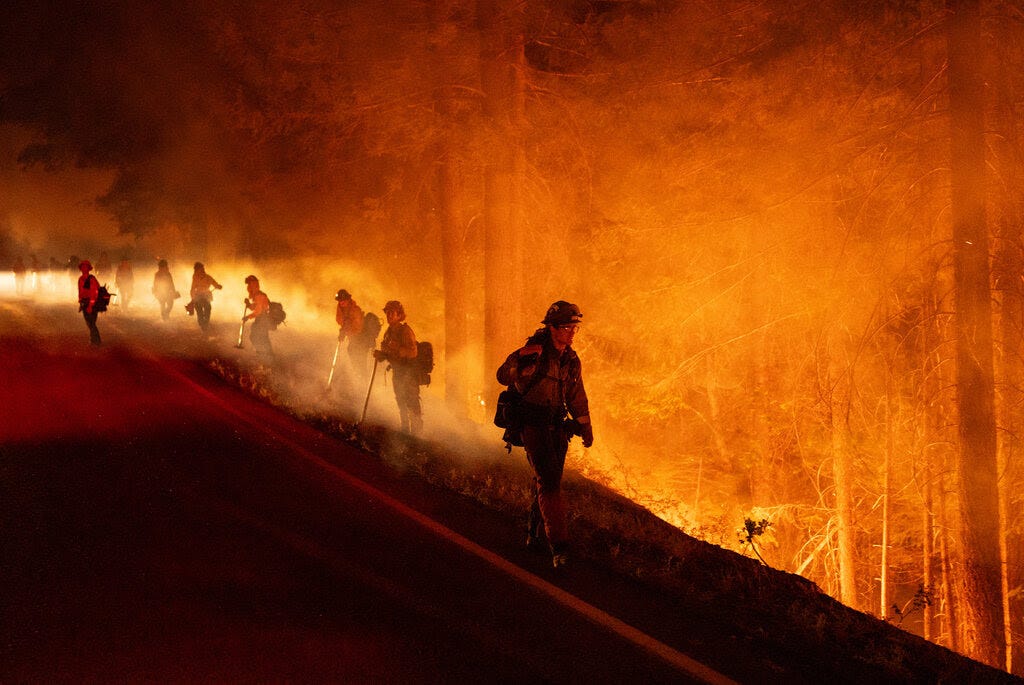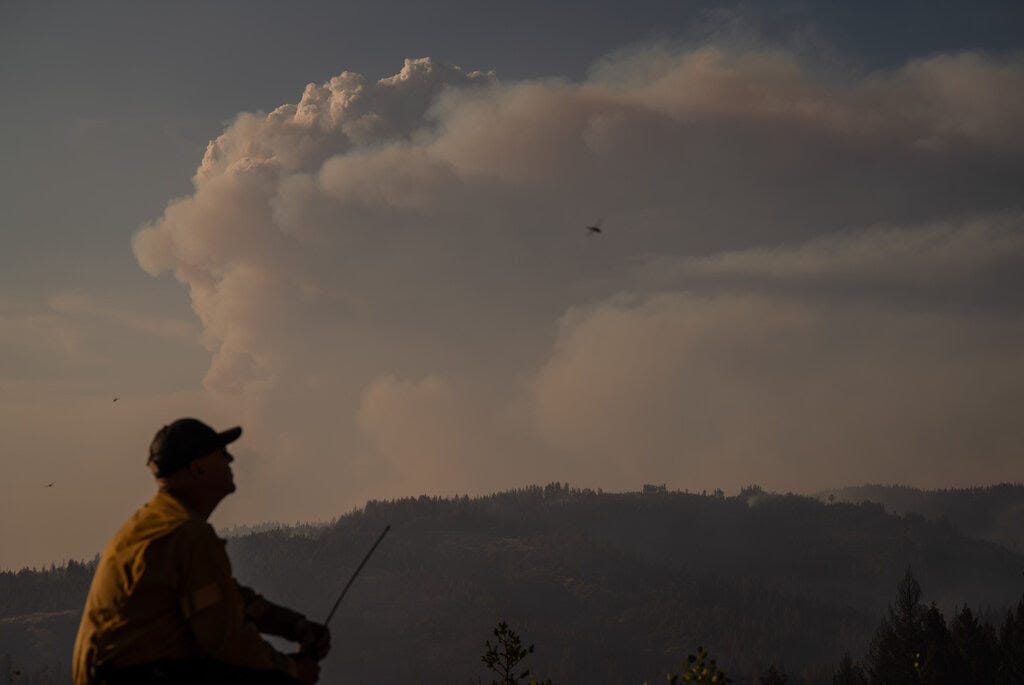Understanding the new era of fire By Manuela Andreoni
New York Times continues to blame climate change for forest fires. More agitprop.
A firefighting crew near Chico, Calif., where the Park fire was burning on Monday. Loren Elliott for The New York Times
Understanding the new era of fire
Seeing wildfires rage around the world feels a lot like watching climate change unfold. Fires have a way of making heat, an often invisible threat, intensely vivid.
It’s no coincidence, then, that the 13 consecutive months of new global heat records continue to fuel extraordinary wildfires all over the planet.
In California, the Park fire became the fifth-largest in state history after it grew to 12 times the size of San Francisco, my colleagues Austyn Gaffney and Isabelle Taft reported. The fire was started by arson, but hot and dry weather had turned the forest into a tinderbox. It could now burn for weeks, if not months, and has the potential to become the largest fire in California’s history.
The Copernicus Atmosphere Monitoring Service, a research organization funded by the European Union, reported this month that fires in Canada were above average in some regions, and about 25,000 people had to be evacuated from their homes when Jasper National Park in Alberta was burned by the biggest blazes it’s experienced in a century.
In Brazil, the Amazon hasn’t seen this many fires in the first six months of the year in almost two decades. And Russia reported a 50 percent increase in area burned compared to last year, as immense blazes sent smoke above the Arctic Circle.
We are still in the middle of summer and it’s too early to tell how the final toll of this year’s wildfires will compare to 2023, when Canada’s fires were more than two times as big as the previous record and Greece experienced the European Union’s largest wildfire ever documented.
The interaction between human actions and a warming atmosphere that turns ecosystems into fuel makes it hard to draw precise global patterns about fires. There are too many variables.
But it’s already clear that the Earth’s hottest months threw things out of whack around the world and helped fuel this year’s wildfires. Today, I want to draw on some of our recent coverage to explain the many ways in which the new age of wildfires is changing our understanding of how our planet’s natural systems work.
Fires are hotter, bigger and arriving earlier
Both the frequency and intensity of extreme wildfires have more than doubled in the last two decades, according to a study Gaffney covered last month. Most of these more powerful fires happened in the temperate conifer forests of the United States and Canada, where extreme fire events increased by more than 11-fold, from six in 2003 to 67 in 2023, and the boreal forests that stretch across North America and Asia, where there was a 7.3-fold increase.
The scientists to whom Gaffney spoke still plan to investigate what made these fires so extreme, but they already know their findings are consistent with the effects of climate change.
Michael Falkowski, who manages the Wildlands Fires program at NASA, explained to me that hotter temperatures make the atmosphere “thirsty” so “it sucks more moisture out of the soil and vegetation.” Drier forests are more flammable and fuel bigger wildfires.
Fire season is also arriving earlier than expected in some places. In the beginning of the year, a time when the rainy season usually has started, the northern tip of the Amazon experienced a record number of wildfires.
Fires are also happening in places that should be too wet to support them. Louisiana, one of the wettest places in the United States, was on fire last year. And now, the Pantanal, the world’s largest tropical wetland, between Brazil and Bolivia, is also experiencing a record number of fires.
A pyrocumulus cloud rising from the Park fire along Highway 32 in California on Monday. Loren Elliott for The New York Times
Climate is not the only factor
In any year, the unfortunate truth is that many fires that wreak havoc in forests are set by people. That’s almost always the case in the tropics, where farmers typically set fires to burn old pasture and foster new crops. Those fires can get out of control.
But other kinds of human activity can also influence fire. The presence of roads around a forest can increase the likelihood of ignition and, subsequently, major wildfires. As my colleagues Ian Austen and Vjosa Isai have shown, some types of logging can make forests more vulnerable to wildfires in Canada, too.
Our food system can make fires more likely, as well. In wetlands, agricultural activity can increase sedimentation, block streams, change water flow patterns and make parts of ecosystems more vulnerable to fires, Amy Pickens, an assistant research professor at the University of Maryland who monitors land cover, told me.
But identifying larger fire trends can be tricky. Pickens said that accounting for both the climate variables and more direct human factors makes it harder to draw patterns across the world.
“It is a mixture of natural and human causes,” she said.
What can be done
The fact that humans are an important factor in the new era of larger and more intense fires also means we are not helpless. National governments can, of course, control climate change. But local policies can help, too.
Indonesia was expected to have a terrible fire season during these extremely hot months, but it didn’t. Some experts say the country’s efforts to fight deforestation are part of the reason its forests were less vulnerable than expected.
Fire suppression policies are a problem, Falkowski, from NASA, told me. Some government agencies in North America now accept that controlled fires, which have traditionally been used by Indigenous people and which were long outlawed, can also help clear the forest of fuels so that wildfires aren’t so dangerous when they break out.
Infrastructure changes that make communities more resilient to fires, such as getting rid of nearby flammable trees and establishing evacuation routes, are also part of the answer.
“Fire is here to stay,” Falkowski told me. “We really have to learn to live with it rather than work against it.”





They would never consider geoengineering dropping chemicals from planes! To electrify the skies and basically set up catastrophic conditions in the forest. Or even the managing of Forest with
Sincere dutiful efforts. It’s always climate change
Promoting their agenda. Dishonest. Yes just send us 78 trillion dollars and we will resolve the “climate crisis”
Targeted DEW's. The bestowing of governmental restrictions on any kind of reasonable maintenance protocols. Geoengineering/stratospheric injection, HAARP, & EMF-related activities (enhanced by the geoengineered saturation of the atmosphere with toxic metals, graphene & microplastics). The indiscreet acquisition of desired lands for control. to restrict human encroachment and to "rewild" areas either earmarked for specific purposes (e.g. on Maui, for Smart/C-40 cities) or cordoned off to preclude further access in perpetuity. Excuse to blame farming, human encroachment, and the excessive requirement of government intervention and control to "preserve" sacred spaces that they have promoted the destruction of. Yes, there are careless people. Yes, there are ecological preventative measures that could be better observed. But fire has always, historically been the preferred method for driving out those who are unwanted and for repurposing the land (usually at discount acquisition costs) for either government oversight and control or for specific projects or for accessing precious resources that could not otherwise be obtained, etc.